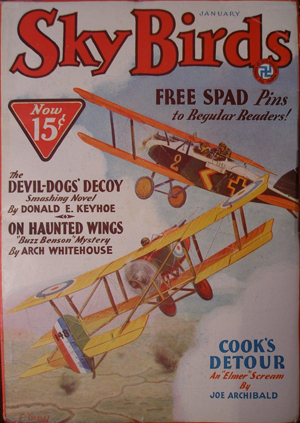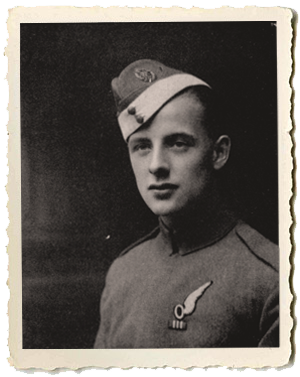“The Broken Parole” by William E. Barrett
 William E. Barrett is an excellent author. Known for such classics as The Left Hand of God, Lillies of the Field, and our own The Iron Ace! In honor of William E. Barrett’s birthday this past weekend, we have for you a tale of broken wings from the January 1933 issue of Sky Birds. The brothers Cord, one stripped of his honor while the other was honor bound not to fly!
William E. Barrett is an excellent author. Known for such classics as The Left Hand of God, Lillies of the Field, and our own The Iron Ace! In honor of William E. Barrett’s birthday this past weekend, we have for you a tale of broken wings from the January 1933 issue of Sky Birds. The brothers Cord, one stripped of his honor while the other was honor bound not to fly!
Flying high in a blood-red sky, von Sternberg had taken toll of the lives of many men. Over the brothers Cord he had thrown an even grimmer shadow, for he had robbed one of his honor, the other of the right to fly. But wings can be built that are too strong to be broken.
“They Had What It Takes – Part 33: Arch Whitehouse†by Alden McWilliams
This week we bring you Part 33 of  Alden McWilliams’ illustrated tribute to the pioneer fliers of the early days of aviation. He called it “They Had What it Takes†and this installment appeared in the October 1939 Flying Aces. It features our old pal here at Age of Aces—Arch Whitehouse. Whitehouse was a prolific writer, both for the pulps and aviation-themed books after the pulps ended. We’ve posted a number of Whitehouse’s stories from Flying Aces and Sky Birds with some of his long running characters like Buzz Benson, Crash Carringer, Coffin Kirk, The Casket Crew, Tug Hardwick and The Griffon!
Alden McWilliams’ illustrated tribute to the pioneer fliers of the early days of aviation. He called it “They Had What it Takes†and this installment appeared in the October 1939 Flying Aces. It features our old pal here at Age of Aces—Arch Whitehouse. Whitehouse was a prolific writer, both for the pulps and aviation-themed books after the pulps ended. We’ve posted a number of Whitehouse’s stories from Flying Aces and Sky Birds with some of his long running characters like Buzz Benson, Crash Carringer, Coffin Kirk, The Casket Crew, Tug Hardwick and The Griffon!
Arch Whitehouse was blessed with a fertile imagination which seemed to spill over into the acounts of his own war record. McWilliams piece and Whitehouse’s own biography, Hell in Helmets, credit Whitehouse with shooting down 16 German aeroplanes—at most he may have had 4 kills—it seems that he was something of a serial exaggerator.
We’ve posted this installment long before we started posting the entire series of Alden McWilliam’s “They Had What It Takes”, but here it is in sequence in case you missed it.
Next time: Clarence Chamberlin—Trans-Atlantic Vet.
“They Had What It Takes – Part 32: “Casey” Jones†by Alden McWilliams
Age of Aces presents the thirty-second installment of Alden McWilliams’ illustrated tribute to the pioneer fliers of the early days of aviation. This week McWilliams chronicles the life and contributions to aviation of aero booster No.1—Charles S. “Casey” Jones. Jones, a veteran of the hell skies of WWI, would rise to prominance as one of the great air racers of his time. He used his popularity to sell the American public on aviation, contributing to radio shows and having columns in two leading aviation magazines—”Flying Colors” in Air Adventures (1928-29) and “Casey Jones’ Flying Course” in Sky Birds (1933-34).
In 1932 he founded the Casey Jones School of Aeronautics along with Lee D. Warrender and George A. Vaughn Jr. The school went through a number on name changes, the most recent was in 2004 when it was remamed after Vaughn.
Casey passed away in February 1976.
“T.N.T. Transport” by Arch Whitehouse
Secret Service agent and flying reporter Buzz Benson approached Sunkist Airport in his slick speedy Corsair for the worst assignment he ever had. Ten days before, three gigantic Boeing transports had vanished from the sky—never to appear again. Was it another Jap plot or something more mysterious?
“The Suicide Strafe” by Major George Fielding Eliot
Those four victories to his credit meant nothing to Bob Sexton—now. At last he had gotten Gerhardt, the invincible German ace—had sent his famous Red-Wing plane crashing down to a fiery doom. Yet that fifth victory—the descendu that made him an ace—was the one he would never be able to claim.
“The Squadron in Scarlet” by Donald E. Keyhoe
Here is another high flying adventure of “Cyclone” Bill Garrity and The Devildog Squadron. For months the grim spectre of that German staffel had stalked up and down the Front, dropping its sinister messages of death upon British and French squadrons. And now at last it struck at the flying Marines. For out of the cloud mists over that Devildog drome a white-winged German plane swooped low, and from it came the threat of doom—a black coffin holding the body of a Devildog pilot.
“The Varnishing Americans” by Joe Archibald
If you thought Elmer Hubbard and Pokey Cook were a couple of wild Indians before, just wait until you see them with their war paint and feathers on! Even C.O. Mulligan had to listen to their war whoops with a smile.
“The Squadron Without a Name” by Donald E. Keyhoe
Once again the Devildog Squadron is roaring into action!
Under guard in his hut—on a double charge of treason and murder! He had led two men out on a secret mission and they had not returned—but he had brought straight to his hidden drome a flock of Boche. And that night he was found beside the body of the man who had called him a spy—and the man was dead, shot through the heart! Yet for Larry Brent, one of those twenty loyal hellions the Boche had named Devildogs, there was always a way out—even though it led to the Squadron Without a Name.
“War Skies of Shanghai” by Arch Whitehouse
Reporter/Flying Ace Billy “Buzz” Benson returns with a new adventure. Westward toward Shanghai, where smoldered a fire of war that threatened to blaze forth and enflame the whole world, a Yankee submarine cut through the waters of the Pacific. Deep in its hold was the Sea Hawk, the plane chosen to carry Buzz Benson straight through the Japanese air zone with secret orders that would mean war or peace. But not twenty cable lengths away steamed a Japanese sub, and in its hold was another Sea Hawk—awaiting the moment when Benson should begin his mad air race to Shanghai!
“Devildog Breed” by Donald E. Keyhoe
Here they are again—that bunch of flying, fighting Devildogs—Lucky Lane and the Three Lunatics, Cyclone Bill Garrity, and the rest of the mad Marines. And fighting against them is a silent, unseen menace—a strange, black shadow that shrouds whole formations in its sable cloak of death, and sends them reeling down—to doom.
“Today We Die” by Frederick C. Painton
The names of the men in that strange, ill-assorted squadron were listed only in the most secret annals of Allied Intelligence. To everyone else they were known merely as the Squadron of the Dead. Americans, British, Russians—even Germans—made up their ranks, and only one bond held them together. They had all been condemned to die! An unusual story of an unusual squadron.
“The Nippon Nightmare” by Arch Whitehouse
The moment Buzz Benson flew over that landing field near the Mississippi River, he knew that something strange, something ghastly, had happened. A weird glow filled the air, and a white dust coated the field like snow. And on that tarmac, where men lay huddled and telephone bells remained unanswered, nothing moved— nothing stirred. Yet it was not death that had claimed them.
“Channel Skimmers” by Joe Archibald
This story features the wacky duo of Elmer Hubbard and Pokey Cook. See how they manage to get themselves into and out of hot water once again.
“Brigand Beacons” by Arch Whitehouse
By day he is a flying reporter for the Los Angeles Mercury newspaper, but Billy “Buzz” Benson’s real job is much more dangerous. He is a secret agent and pilot extraordinaire for the U.S. military. And his chief mission is keeping the emerging Japanese threat in the Pacific at bay. In this tale he is on hunt for “The Fiends of Fujiyama” and some stolen experimental weapons.
“Fat Cance” by Major George Fielding Eliot
Everyone likes a fat guy, unless they have to fly with him. “Tubby†Gorkin could barely fit into the rear observer’s cockpit and no pilot wanted him as their observer. Now, with a new hard edged C.O. coming on, it looked like the end of Tubby’s dream of becoming a pilot.
 William E. Barrett is an excellent author. Known for such classics as The Left Hand of God, Lillies of the Field, and our own The Iron Ace! In honor of William E. Barrett’s birthday this past weekend, we have for you a tale of broken wings from the January 1933 issue of Sky Birds. The brothers Cord, one stripped of his honor while the other was honor bound not to fly!
William E. Barrett is an excellent author. Known for such classics as The Left Hand of God, Lillies of the Field, and our own The Iron Ace! In honor of William E. Barrett’s birthday this past weekend, we have for you a tale of broken wings from the January 1933 issue of Sky Birds. The brothers Cord, one stripped of his honor while the other was honor bound not to fly! 




 Alden McWilliams’ illustrated tribute to the pioneer fliers of the early days of aviation. He called it “They Had What it Takes†and this installment appeared in the October 1939 Flying Aces. It features our old pal here at Age of Aces—
Alden McWilliams’ illustrated tribute to the pioneer fliers of the early days of aviation. He called it “They Had What it Takes†and this installment appeared in the October 1939 Flying Aces. It features our old pal here at Age of Aces—